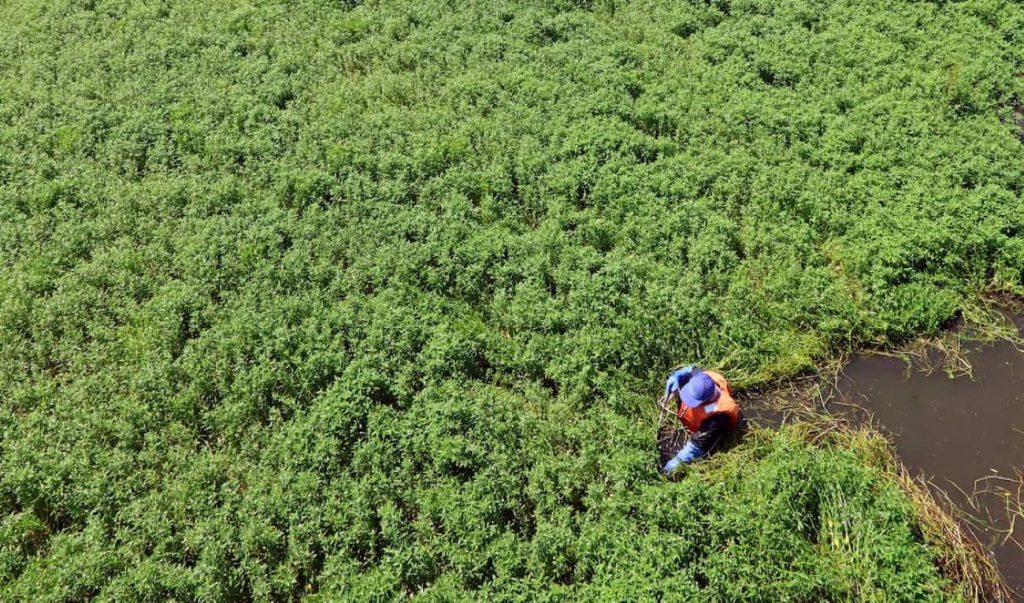このページを 日本語 で読む
Twenty years ago, in 2005, Japan began enforcing the Invasive Alien Species Act (IAS Act). This law regulates the import and cultivation of non-native invasive species that can have an especially adverse effect on human health and ecosystems, including agriculture, forestry, and fisheries.
Over the past two decades, citizen groups and local governments have undertaken extermination activities to the best of their ability. However, no fundamental solution has been found.
Alligator weed (Alternanthera philoxeroides), an invasive aquatic plant, is one example. It has been wreaking havoc on riverbeds, lakes, and waterways west of the Kanto region. When it invades rice paddies, it represents a serious blow to farmers. These weeds sink their roots deep underground, reducing rice yields and causing the rice plants to topple over. They even interfere with the operation of combine harvesters during the autumn harvest.
It is an aquatic plant native to South America and described as "the worst invasive plant on earth." Now, it is also a serious threat to Japan's rice cultivation.
The water primrose (Ludwigia grandiflora) is another example. It is also considered one of the "strongest and most dangerous" invasive aquatic plants and is therefore viewed with considerable concern.
Infamous alien invasive fauna species include the (American) red swamp crayfish (Cambarus clarkii) and the largemouth bass (Micropterus nigricans). Among plants, goldenrod and ragweed are also well-known. Even regular static plants are not to be underestimated.
However, it is the aquatic plants that are shaking up Japanese society the most.
Three Key 'Don'ts'
On this 20th anniversary of the implementation of the IAS Act, we should renew our awareness of the threats posed by invasive alien species. Broad cooperation is needed to prevent the spread of damage caused by them.
The three cardinal principles for preventing damage by invasive species are "don't introduce," "don't discard," and "don't spread." Unfortunately, these rules have not been fully adhered to.
With the expansion of international logistics, Argentine ants and fire ants have snuck into Japan by hitching rides on imported cargo. Red swamp crayfish and red-eared slider turtles (Trachemys scripta elegans) became a problem when people tired of raising them as pets and abandoned them. Largemouth bass and bluegill (Lepomis macrochirus) have also expanded their distribution because of the illegal release of fish.
Minimizing the Damage
There have also been some notable successes. One is the eradication of mongooses on Amami Oshima.
However, it is difficult to eradicate invasive species that have spread nationwide and have a high reproductive capacity. In reality, we have no choice but to coexist with these unwanted intruders. Meanwhile, every possible step should be taken to minimize the damage they cause.
Ultimately, the widespread damage caused to Japan's agriculture by invasive species cannot be ignored.
Aside from invasive plants, golden apple snails (Pomacea canaliculata), native to South America, cause severe damage by eating rice seedlings. Nutria (Myocastor coypus) is another invader. These are semi-aquatic rodents from South America that destroy vegetables and rice. Raccoons also target crops.
Collectively, the damage inflicted by these pests acts as a heavy burden on local economies.
According to the Ministry of the Environment, as of the end of 2024, there were 162 types of designated invasive species. In fact, the total has doubled over the last two decades or so. Meanwhile, environmental and economic pressure from the invasion of alien species continues to grow.
RELATED:
- Japan's Mongoose Eradication is Good News for Biodiversity
- 'Super-Invasive' Fish: Environmental DNA Study Reveals Ecosystem Threat
(Read the editorial in Japanese.)
Author: Editorial Board, The Sankei Shimbun
このページを 日本語 で読む
